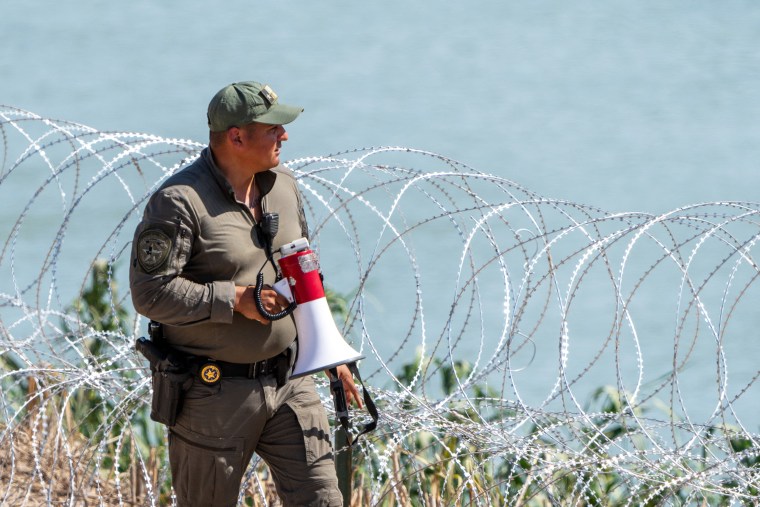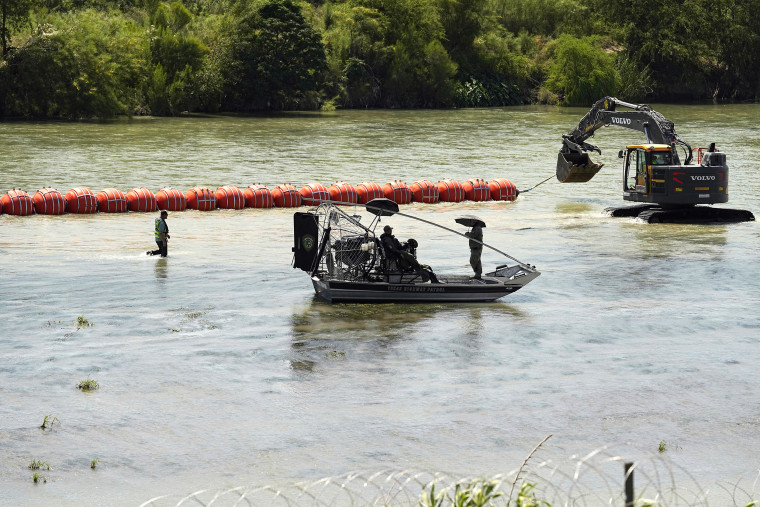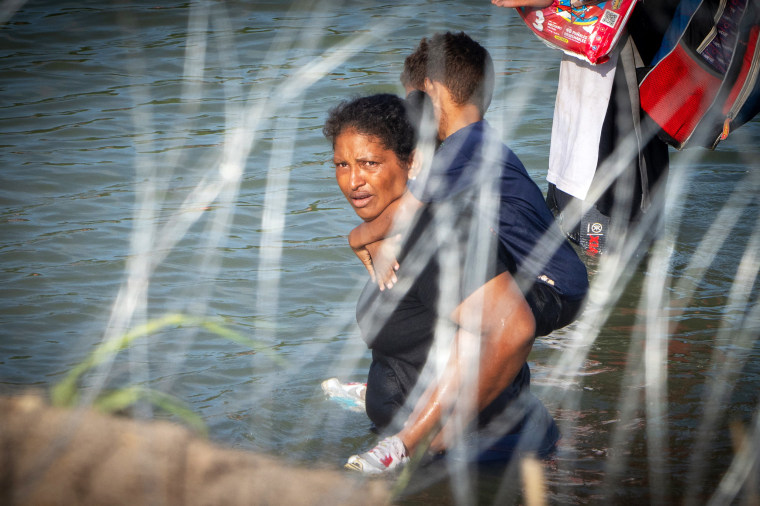Since 2021, the city of Eagle Pass, along the banks of Rio Grande and just a few hours from San Antonio, has been a prime crossing point for people seeking to turn themselves in to U.S. authorities and ask for asylum, as is their legal right. Between Eagle Pass and Piedras Negras, Mexico, though, the Rio Grande is especially dangerous.
Between Eagle Pass and Piedras Negras, Mexico, the Rio Grande is especially dangerous.
On Sept. 1 last year, 13 migrants drowned there. Earlier in 2022, authorities had recovered 12 bodies from the river in a single day. On the first day of this month, authorities recovered the bodies of a Guatemalan woman and her infant daughter.
A normal country, and state, would act to prevent such deaths by making the crossing safer, or even making crossing a dangerous river unnecessary. But Texas, which has strung miles of razor-sharp coils of concertina wire along the riverbank and shallows, and is building a 1,000-foot floating “wall” of buoys in the middle of the river in front of downtown Eagle Pass, is deliberately making the Rio Grande more dangerous to cross.
And according to a Texas state trooper whose email to a superior was published by the Houston Chronicle, authorities along the border have been ordered to put individual migrants in more danger. According to that trooper, those orders have included pushing desperate migrants back into the river.
State Trooper Nicholas Wingate is a medic assigned to Texas Gov. Greg Abbott’s state-funded border security crackdown in Eagle Pass, and according to his email, the results of Texas' efforts to make crossing the river more dangerous have been horrifying:
● On June 25, troopers found 120 people, exhausted during an intense heat wave, waiting to turn themselves in on the riverbank. The Texas Department of Public Safety (DPS) commanding shift officer twice gave orders “to push the people back into the water to go to Mexico” despite the drowning risk.
● On June 30, Texas National Guardsmen, acting on orders, “pressed back” a 4-year-old girl on the riverbank alongside coils of wire. The girl passed out in the heat.
● That day, troopers found a man with “a significant laceration in his left leg” from the concertina wire. He told troopers that his child was “stuck on a trap in the water”: a barrel wrapped in sharp wire.
● Also that day, a 15-year-old boy broke his leg when, in an effort to avoid the wire, he re-entered the river in an area of dangerous currents.
● That evening, troopers came across a 19-year-old woman “who was in obvious pain,” stuck in the wire and “doubled over.” She was having a miscarriage.
The Houston Chronicle had previously reported on the federal Border Patrol’s concern that the concertina wire would complicate rescues. On June 30, Fox News showed Border Patrol agents using shears to cut through the wire to reach migrants in the river.
A spokesperson from the Texas DPS provided the Houston Chronicle with a recent email from its director, Steven McCraw, to state troopers, in which he writes, “The purpose of the wire is to deter smuggling between the ports of entry and not to injure migrants,” although that has been a frequent result. McCraw continued, “The smugglers care not if the migrants are injured, but we do, and we must take all necessary measures to mitigate the risk to them including injuries from trying to cross over the concertina wire, drownings and dehydration.” A statement from the Texas governor’s office adds, “The absence of these tools and strategies—including concertina wire that snags clothing—encourages migrants to make potentially life-threatening and illegal crossings.”
The statement fails to mention the wire’s tendency to snag human flesh.
Abbott’s office denies that it has given “orders or directions… that would compromise the lives of those attempting to cross the border illegally.”
Abbott’s office said it hasn't given any “orders or directions… that would compromise the lives of those attempting to cross the border illegally.” The emerging evidence, though, says otherwise. In its day-to-day operations in Eagle Pass and elsewhere, Texas’s state border management is upholding and rewarding troopers and guardsmen who block migrants seeking protection.
In 2021, Abbott launched what he calls “Operation Lone Star,” which has given police and those in the National Guard the power to arrest migrants and jail them for trespassing. At the same time, the state continues to build sections of a state-funded border wall.
Though the alleged orders to harm people in Eagle Pass came from Austin, and not Washington, the severity of these ongoing human rights violations demands that the Justice Department act to stop them. However, the Eagle Pass incidents are hardly the only case of government personnel ordered to inflict cruelty on asylum-seekers and other migrants at the U.S.-Mexico border. The federal government does this, too.

The Trump administration’s family separation policy ordered federal border agents to wrest traumatized children from their parents’ arms. Policies like “metering,” that is, blocking asylum-seekers’ access to official border crossings, and the Title 42 pandemic order expelled protection-seeking people — often as they pleaded for mercy — back into Mexican border cities, where thousands were assaulted, kidnapped, raped or killed.
Today, federal agents are subjecting thousands of asylum-seeking migrants to “expedited removal,” forcing them to defend their asylum pleas within days from Customs and Border Protection’s jail-like holding facilities, with almost no access to counsel. It’s a process that some asylum officers call “frustrating” because of the likelihood that some migrants may be deported to danger.
Other cruelty happens on a more ad hoc basis, without specific orders. The Washington Office on Latin America, where I work, has collected over 400 examples since 2020 of federal U.S. border agents misusing force, endangering children, denying food or medical care in custody, failing to return belongings and separating families, among other allegations.
Federal agents are subjecting thousands of asylum-seeking migrants to “expedited removal,” forcing them to defend their asylum pleas within days jail-like holding facilities.
These agents aren’t necessarily responding to orders, but they’re hardly ever punished within the Department of Homeland Security’s byzantine accountability system. Instead, they operate within an organizational culture that views undocumented migrants as deserving of harsh treatment. That culture often takes a dark view of asylum-seekers, who only started arriving at the U.S.-Mexico border in large numbers in 2014.
Cruelty at the border is not just meted out on a face-to-face, individual basis. It is often the consequence of broad laws and policies.
The United States has an aging native-born population and faces labor shortages. Many other nations have younger populations who see few opportunities at home or are fleeing threats to their lives. Rather than welcome more people, though, the United States has kept admission and work visa numbers unchanged since the 1990s and built a system of barriers, both physical and legal, to block most others. Over the past 30 years, the U.S. government has built over 700 miles of barriers and quintupled the size of Border Patrol.
The underlying policy, “prevention through deterrence,” arises from the absurd idea that migrants won’t come if the experience at the U.S. border can be made miserable enough. A big part of increasing misery would involve redirecting migrants to “more hostile terrain,” as Border Patrol’s 1994 National Strategy put it.
This was the federal government equivalent of stringing up razor wire. Since 1998, Border Patrol has found the remains of more than 9,500 migrants on U.S. soil, mostly in hostile terrain such as deserts: dead of dehydration, excessive heat and cold, drownings, and —increasingly — falls from the border wall. Migrant deaths are on the rise, with more than 890 reported in 2022. On a single weekend this month, 10 died in the dangerously high heat.
In a precursor to what Texas is doing now, the U.S. increased the risks at the border but didn’t deter migrants. We’re in a time of historic migration worldwide, and arrivals at the U.S.-Mexico border are near all-time highs.
In a precursor to what Texas is doing now, the U.S. increased the risks at the border but didn’t deter migrants.
That lack of deterrence shouldn’t surprise us. It’s laughable to imagine that some misery the U.S. inflicts might deter someone who has lived in one of the world’s most violent and deprived places and journeyed thousands of miles through treacherous jungles and roadways, contending with bandits, kidnappers and corrupt officials.
Nobody survives all that, sees Abbott’s buoys and razor wire and says, “What a shame, I guess I’ll have to go back to Venezuela.”
The Biden administration deserves some credit for recognizing this reality, even as it continues carrying out “prevention through deterrence.” The administration has increased legal pathways for some migrants, using expanded appointments for some asylum-seekers using a smartphone app and a “humanitarian parole” program for some citizens of Cuba, Haiti, Nicaragua and Venezuela.

Those who cannot access these options, though, can expect cruelty: in the expedited removal and deportation process, in ICE’s detention centers or at the hands of Greg Abbott’s police and guardsmen.
“We need to recognize that these are people who are made in the image of God and need to be treated as such,” Wingate wrote in his email. We owe gratitude to him and other brave personnel who’ve balked at their apparent orders. Those who’ve voiced alarm at the Rio Grande events have apparently managed to keep their humanity intact in an atmosphere of policies — new and old, state and federal — that discourages it.
They’re pushing back against a dark and embedded part of U.S. political culture that thrives on fear of the “other” and denying civil rights. It’s up to us, and our leaders, to follow their lead and push back, too. Not just in Texas, but everywhere.
